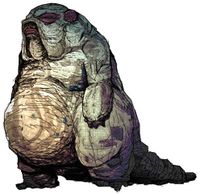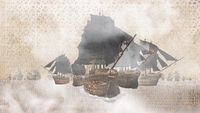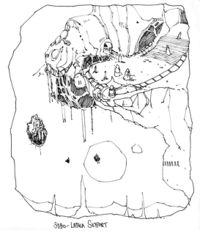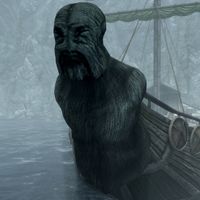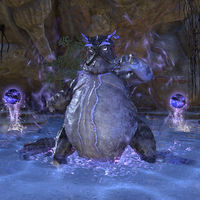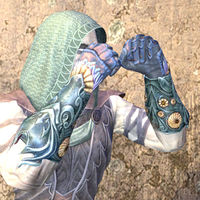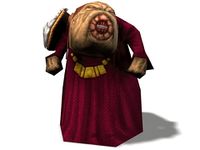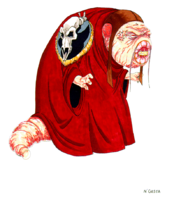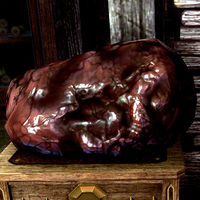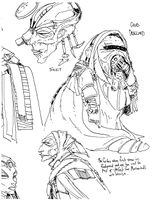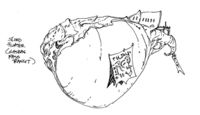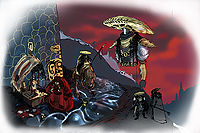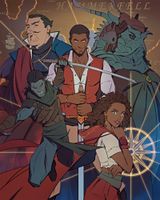Lore:Sload
This article is about the race. For the language, see Sload (language).
—Lost Tales of the Famed Explorer: Fragment IV
The Sload (sometimes called Slugmen,[1] slug-folk,[2] slug people,[3] grubs,[UOL 1] or worms)[4] are a race of slug-like (sometimes described as toad-like)[5] beastfolk native to the Coral Kingdoms of Thras, west of Tamriel.[6][7] They are semi-aquatic, corpulent beings, known to grow to massive sizes. Their culture is largely based on necromancy.
Not much is known of their history, as the Sload Coral Kingdoms have generally followed an isolationist policy, mostly due to often being at war with the rest of Nirn, but they have had diplomatic relations with the Maormer of Pyandonea.[1] They are described by the Khajiit explorer Ja'dasha as among the most horrible and dangerous creatures of the sea, along with krakens and sea serpents.[8] They are particularly infamous for releasing the Thrassian Plague upon Tamriel in 1E 2260, killing more than half of the population.
Contents
History[edit]
Early History[edit]
The Sload are in recorded history as early as the Early Merethic Era, when the Aldmer migrated from Aldmeris to Summerset.[9] Though they likely existed prior, as Vivec is said to have claimed that during the first of the "Altmeri formwars" his people sieged the "necromantic meatmerchants of Thras".[UOL 2] The Sload were said to occupy the Southern Sea.[10][11] The Sload of Thras may have been original inhabitants of Summerset as well,[6] as the oldest of all the ruins there are made of coral, thought to have been carried a great many miles away from the sea. The material and style of the ruins strongly suggest that the Sload may have once counted Summerset as a part of their kingdom of Thras.[12]
The Sload have used necromantic magic and infernal machines to attack the Altmer since before recorded time, conjuring sea monsters along the coasts and capturing many Altmer, though they have never succeeded in reclaiming Summerset.[6] An unnamed ship of Topal's fleet traveled northwest of Summerset, towards Thras and Yokuda. It is thought that this ship and Pasquiniel may have perished at the hands of the ancient Sload, as they did not return.[13]
The sload visited horrors upon Summerset during the Sack of Skywatch in 1E 1301, capturing some Altmer to bring them back to Thras.[12] The few Altmer that escape mention being kept in a lagoon at the center.[6]
Thrassian Plague and Fall of the Sload[edit]
The Sload unleashed the Thrassian Plague in 1E 2200 through the use of infected gastropod sea beasts sent onto the coastlines.[14] Divayth Fyr asserted in his "Pestilent Progeny Thesis" that the infectious slugs the Sload sent to Tamriel were mutated versions of the Sloads' own infantile larvae.[15] The Thrassian Plague began to rapidly spread through Tamriel, leaving hundreds of thousands of misshapen corpses in its wake and afflicting the populace with symptoms such as boils, brittle bones, seeping mucous from the eyes and ears, and an unquenchable thirst that drove people to madness. The Plague proved resistant to attempts at a cure, and a number of unsung heroes laid down their lives in search of one in vain, managing only to confirm the suspicion that the disease was unnatural and had originated from the Sload of Thras.[16] At its height, the disease was described as ever penetrating, seeping into every person, every creature and every drop of water,[17] and soon over half the population of the continent was dead, particularly along the western coastlands closest to Thras.[18][19]
In retaliation, Bendu Olo, the Baron-Admiral of the All Flags Navy, led the largest allied naval force in Tamrielic history against Thras. During the construction of the fleet in the Systres shipyards, the nascent All-Flags Navy had to contend with the Molmor, the greatest of the sea beasts unleashed by the Sload. Described as a cross between a massive whale and an octopus, with a "veritable forest of spines, each longer than the lance of a knight", the massive creature proved impervious to all attempts to slay it, until a young Druid of the Eldertide Circle named Belaigh tricked it into consuming an enchanted clod of ground which petrified it and turned it into Molmor Islet.[16][20] The fleet was beset by Sload raids as it crossed the seas to reach Thras. Accounts by a Dunmer fleet captain describe great sea beasts, resembling blighted whales, rising from the water. The fleet was sprayed with clouds of acidic ichor that dissolved everything it touched, and stopped only when it was set aflame. At the same time, Sload riders used powerful spells that made the elves on board clutch their heads in pain until all the Sload were slain. Unlocking the secret to breaching the Sload sea beasts proved to be a turning point to the conflict, as prior to that the Sload could attack with impunity from beneath the waves. It is theorized that Archmage Syrabane might have had a hand in this, as his focus throughout the conflict appears to have been arcane naval warfare, though the details remain hazy.[16]
Eventually the All-Flags Navy prevailed, sinking the Sloads' coral kingdoms in an event known as the Fall of the Sload.[21][22] A great Coral Tower was present Thras' largest island Agonio, and it was the destruction of this arcane edifice that created the giant whirlpool that sunk the archipelago and a section of the All-Flags fleet.[23][1]
It is unknown when the disease fully subsided, as cases of the Thrassian Plague were still being reported near Wayrest over four hundred years after its initial outbreak.[24] The influence of the disease was so pervasive that certain locations such as the Corgrad Wastes were reputed to bear a taint of corruption even well into the Second Era.[25] The effects of the Plague and the Fall were very impactful, Olo was thereafter known as the "Dealer of Swift Justice to the Foul Spot of Thras",[22] and the glory of the Cyrodilic people became known throughout the world.[18] Elsweyr was reduced from 16 down to 2 kingdoms,[26] Valenwood later fell to the Empire from being weakened by the plague,[27] and Hammerfell was on friendlier terms with its neighbors, all as a result of the Fall.[28]
Post-Sinking and Rise of Thras[edit]
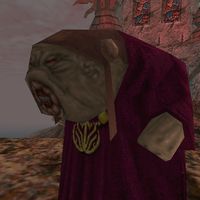
The Sload were long presumed extinct after the Fall.[22] They recovered by the end of the era, and waged the War of the Uvichil from 1E 2911 to 1E 2917, regarded as one of the most terrible events in Tamriel's history.[12]
By 2E 864, Thras was considered a "free" or "wild region" by the Septim Empire, and it was reported that it had risen again. Imperial authorities encouraged citizens to report the existence of its masters, the Sload, if seen in the various areas of Tamriel.[22]
In 3E 120, maps of lands beyond Tamriel, including Thras, could be seen in the Map Room of the Blue Palace.[29] By the waning years of the Third Era, from 3E 402 to 3E 432, the western seas were very quiet and Agonio had become considerably great in size, giving hope to Tamriel that the Sload had retreated back to Thras for good.[6]
Following the Warp in the West in 3E 417, it was said that the Sload priests began talking to their new God of Worms.[30] Only a few Sload necromancers operated successfully in Black Marsh around 3E 427, and even then they were only active near the coast.[7] During the Mages Guild debate regarding outlawing Necromancy, Ulliceta gra-Kogg said necromancers are the scourge of Tamriel, whether operating independently or in concert with the sloads or King of Worms.[31]
Society and Culture[edit]
They are highly intelligent and skilled at magic,[22] and their mastery of necromancy is renowned.[6] They supposedly only practice Necromancy on other races, which some say explains the number of slaves they purchase in Tear, and the rumors of Sload airships carrying corpses from Senchal.[7] Said airships are known as Sload floaters, which are living gasbags, used for mass transit and warfare.[UOL 3][UOL 4]
Sload are innately cautious and careful, and in their mythic traditions their heroes spend years planning, considering and consulting with wise Sload before taking the correct action and achieving their goal. By contrast, their villains all act quickly or rashly and always fail. The Sload language has no word for 'adventure', and the closest equivalent more accurately means 'tragic disaster'.[22] Similarly to the Khajiit, the Sload are known to speak in the third person.[4]
According to Bendu Olo, Sload do not seem to experience emotions as the Tamrielic races do, but are often skilled at acting and may exaggeratedly simulate them for the benefit of more emotive beings.[22] They will honor laws, loyalties, and friendships only as long as they calculate it to be in their best interests to do so. They also have no compunctions against blasphemy, theft, kidnapping, murder, genocide or anything else that may help them reach their goals.[22]
Sload are apparently not religious and generally reject worship, but will willingly serve Daedra if they benefit from it.[2] Some, in particular the famed Second Era necromancer N'Gasta, also follow the King of Worms.[4][30][UOL 5] Despite their general rejection of worship, some accounts describe the Sload engaging in elaborate sacrificial rituals which involve individuals with years of preparation re-enacting the deeds of mythical heroes and villains, before sacrificing themselves via the application of "dessication crystals" to their bodies. Such rituals have been theorized to be a form of worship directed towards the Sload ancestors, or towards unnamed deities of theirs.[2]
Texts appropriated from a defeated Maormer fleet describe an audience with an "Elder Distended One" taking place in a submerged tower. The Elder is described as having an "impressively corpulent body and strangely pulsating head" as well as "three eyes that emerged upon its belly" that each opened again as a "toothless mouth" which disgorged undefined objects its attendants eagerly consumed. This account has been theorized to describe the cultural leadership of the Sload. The same text describes a visit a "Menagerie of Sublime Infection" where all manner of afflictions such as "blood rot" and "festering myriasis" are kept. The facility is thought to represent a "grotesque fascination" with disease.[2]
Due to their slippery grip, Sloads have eschewed the use of most tools. They do use armor on occasion, as their flabby bodies don't provide much natural protection. In these armors, they are known to use the shells of large nautiluses, cephalopods native to the waters around Agonio.[32] Despite their size, Sloads were known to engage in fencing, and developed an intriguing regimen known as 'Welcoming the Cut.'[33]
Biology[edit]

It is unknown exactly how Sload reproduce. They are believed to be hermaphrodites in their youths, though the sexual organs seem to be absorbed by the time they are old enough to survive on land.[34] Adult Sload parents care little for the fate of their young they created prior in their life, and will often kill them to make Sload Soap, which they use in necromantic rituals. Sload begin their lives as "disgusting little amorphous grubs" according to Bendu Olo, leader of the punitive expedition sent by Tamrielic nations to Thras after the Thrassian Plague. The young Sload mutate into aquatic quasi-cephalopods called "polwygles" before they reach adulthood.[1][35] Sloads are thought to be incapable of having mixed offspring with Man, Elves, and other Beastfolk, and as such they are not considered to be human.[36]
Due to the corpulence of the adult Sload's slug-like humanoid body, they are said to spend much of their time wallowing in shallow lagoons and move very slowly.[1] Though according to another, while slow elsewhere, the buoyant Sload move about with relative quickness and grace in the brackish lagoon at the center of the Thras island chain, through an intricate network of coral formations and ancient shipwrecks.[6] The integument of Sload can slowly adapt to objects and surfaces, which allows them to climb surfaces like slugs.[22] Despite their resemblance to slugs, Sload have skulls.[UOL 5]
Sea Sload[edit]
Sea Sload are a species of Sload that are known to be even more reclusive than their Thrassian cousins. They are known to rule realms in the Sea of Pearls, with one such realm being the undersea kingdom of Ul'vor Kus. In addition to necromancy, the Sea Sload are also skilled in the arts of alchemy, shadow magic, and mind magic, as well as other arcane disciplines.
Unlike regular Sload, which organize themselves in small kingdoms, Sea Sload often tend to form cabals among themselves to achieve common goals, which then break up or reform as those goals change. They utilize various deep sea creatures as servants and soldiers, which they address through a combination of the guttural Sload language and mind magic. The Yaghra, which were created from crustacean-like bottom feeders, are their most common servants. Yaghra Striders appear to revere the Sea Sload as their gods.
In appearance they are more colorful than typical Sloads, possessing bioluminescence and long antennae. Overall they resemble nudibranchs (or sea slugs) more than land slugs.
Artifacts[edit]
Thrassian Stranglers[edit]
The Thrassian Stranglers are a pair of armored gloves created by the Sload of Thras. They imbue their wearer with arcane might borne from Thrassian magics that makes them more effective with their weapons and spells and this power grows the longer the stranglers are used. However these powers come at a price, as the more their power grows the more their fortitude drops, and as a result they are able to take less punishment.
The gloves themselves cover the hands and most of the forearms up to the elbows, and are made up of several parts, all of which either originate or were scavenged from the Thrassian Archipelago. The materials used in their creation suggests they were made to be lightweight but durable. The metal parts of the gloves are made of frog-metal, an alloy that is buoyant enough to float instead of sink, which was likely scavenged from the sunken wrecks of Altmeri naval vessels. The plating of the gloves consists of dense corals harvested from the formations around Thras. These corals provide advantages such as durability and lightness. Other parts of the gloves' exterior are made from a sticky leather that is believed to either be a natural waste product of the Sload that is shed when they grow, or flayed from their own children. The remainder of the gloves are made up of nautilus shells and swamp anemones. The shells are set into the exterior and are a durable yet lightweight form of protection. The purpose of the inlaid anemones is less understood but it is possible that their slime is useful in Sload magics.
Gallery[edit]
Notes[edit]
- "Sload" is a portmanteau of "slug" and "toad".
- "Sload-marched" was an idiom used by some to describe taking someone somewhere by force,[37] a play on the term "frog-marched".
- A ship in the Fourth Era was named the Dainty Sload after the Sload.[38]
See Also[edit]
- Sload Names
- For a list of notable Sloads, see here.
- For game-specific information, see the Elder Scrolls Online
 article.
article.
Books[edit]
- A Loathsome Civilization by Telenger the Artificer — A scholar's research notes on the Sload
- Further Notes on the Sload by Telenger the Artificer — A noted scholar discusses the sload and their soap in some detail
References[edit]
- ^ a b c d e Further Notes on the Sload — Telenger the Artificer
- ^ a b c d A Loathsome Civilization — Telenger the Artificer
- ^ Guide Culast's dialogue in ESO
- ^ a b c N'Gasta's dialogue in Redguard
- ^ An Argument For Common Sense — Uruld, preserved by Gollred
- ^ a b c d e f g Pocket Guide to the Empire, 3rd Edition: Other Lands — Imperial Geographical Society, 3E 432
- ^ a b c Corpse Preparation
- ^ The Elder Scrolls: The Official Survival Guide to Tamriel — Tori Schafer
- ^ Auridon Explored, Chapter XII — Fenlil the Wayfarer
- ^ The Lay of Firsthold
- ^ Serpent's Grotto loading screen in ESO
- ^ a b c Pocket Guide to the Empire, 3rd Edition: The Blessed Isle: Alinor and the Summersets — Imperial Geographical Society, 3E 432
- ^ Father of the Niben — Florin Jaliil
- ^ Captain Tendil's dialogue in ESO
- ^ Telenger the Artificer Answers Your Questions 2 — Telenger the Artificer
- ^ a b c Systres History — Trilam Heladren, Associate Dean of Eltheric History, University of Gwylim
- ^ Kinlord Nemfarion's dialogue in ESO: Summerset
- ^ a b Pocket Guide to the Empire, 1st Edition: Cyrodiil — Imperial Geographical Society, 2E 864
- ^ Pocket Guide to the Empire, 3rd Edition: All the Eras of Man, A Comprehensive History of our History — Imperial Geographical Society, 3E 432
- ^ Belaigh and the Molmor — Sirino Hentor, Elder Historian
- ^ Varieties of Faith... — Brother Mikhael Karkuxor of the Imperial College
- ^ a b c d e f g h i Pocket Guide to the Empire, 1st Edition: The Wild Regions — Imperial Geographical Society, 2E 864
- ^ Journal of Tsona-Ei — Tsona-Ei
- ^ Wayrest, Jewel of the Bay — Sathyr Longleat
- ^ Justiciar Farowel's dialogue in ESO: Summerset
- ^ Pocket Guide to the Empire, 3rd Edition: Sugar and Blood: the Cats of the South — Imperial Geographical Society, 3E 432
- ^ Pocket Guide to the Empire, 3rd Edition: The Wilds Remain: Valenwood — Imperial Geographical Society, 3E 432
- ^ Pocket Guide to the Empire, 3rd Edition: The Ra Gada: Hammerfell — Imperial Geographical Society, 3E 432
- ^ The Wolf Queen, v5 — Waughin Jarth
- ^ a b People of Morrowind — Various
- ^ The Black Arts On Trial — Hannibal Traven, Archmagister of the Mages Guild
- ^ Nautilus Shell Guards item description in ESO
- ^ Lord Fa-Nuit-Hen and Tutor Riparius Answer Your Questions 2 — Fa-Nuit-Hen and Tutor Riparius
- ^ Notes on Racial Phylogeny — the Council of Healers, Imperial University
- ^ The Alchemist's Formulary
- ^ Dialogue in Morrowind
- ^ Lozruth's dialogue in ESO
- ^ Dainty Sload in Skyrim
Note: The following references are considered to be unofficial sources. They are included to round off this article and may not be authoritative or conclusive.
- ^ Grub Druglord concept art for Morrowind
- ^ How Beautiful You Are That You Do Not Join Us
- ^ Sload Floater and Skyport concept art
- ^ Nemon's Memorystone — Nemon
- ^ a b Ted Peterson's posts in War of the Wormgod
| |||||||||||||||||||||||||||||||||||||||||||
